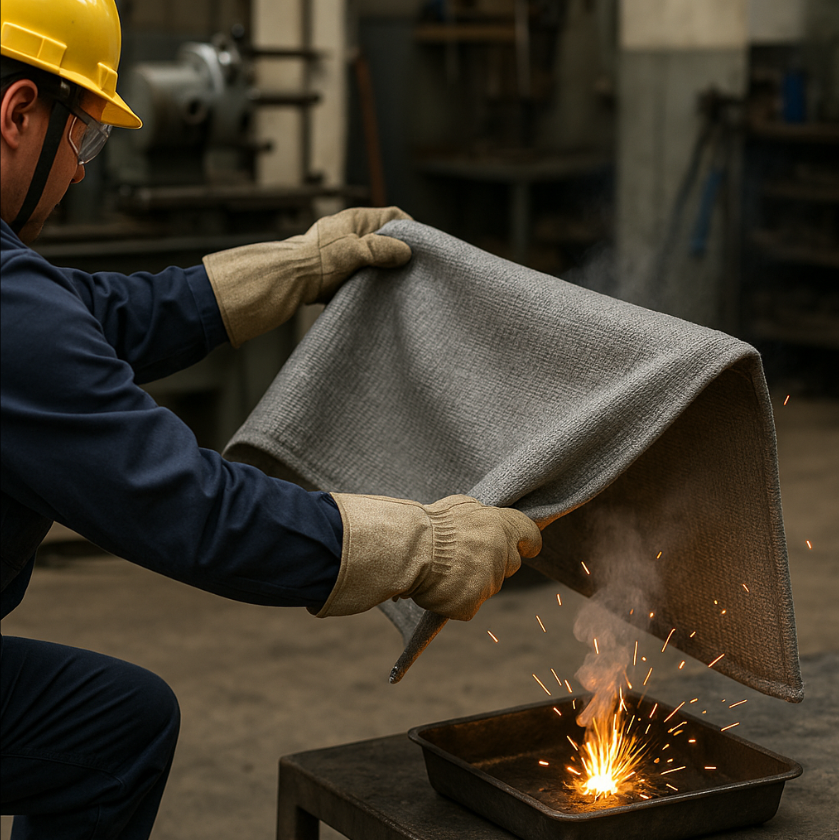- July 2, 2025
- Posted by: wellcoindustries
- Category: Fiberglass fire blanket
Introduction
Passive fire protection often decides whether a flare-up stays small or spirals out of control. Whether you’re fabricating rebar, curing composites, or tending greenhouse heaters, you need a barrier that moves from storage bag to flame suppression in seconds. Fiberglass fire blankets fill that role: pliable, silica-rich textile shields proven across agriculture, construction, and OEM plants.
As a vertically integrated supplier, Wellco Industries weaves, coats, and finishes its own glass fabrics, then ships them alongside erosion-control nets and composite profiles on a single bill of lading—reducing lead-time headaches for purchasing managers.

What Are Fiberglass Fire Blankets and How Do They Work?
Composition and Heat-Resistant Properties
Commercial blankets are woven from E-glass or 96 %-silica E-glass. Uncoated filaments tolerate ≈ 550 °C continuous service and short bursts above 1 000 °C; silicone or vermiculite coatings add abrasion resistance and seal stray fibres. A Material Safety Data Sheet confirms the filaments are non-respirable (> 9 µm) and non-combustible .
Extinguishing Mechanism vs. Traditional Extinguishers
Draped over a flame, the dense weave blocks oxygen and soaks up radiant heat without the corrosive powders that dry-chemical extinguishers leave behind.
Are Fiberglass Fire Blankets Safe to Use? Key Safety Factors
Material Integrity, Off-Gassing, Skin Irritation
Independent testing shows < 2 % mass loss after three cycles at 800 °C, safely inside the NFPA 701 tolerance window . Minor itching from raw edges is solved by gloves and sleeves. Air monitoring during Wellco trials recorded fibre dust at < 1.2 mg/m³—well below OSHA’s 5 mg/m³ PEL and with no carcinogenic concern per OSHA’s HazCom memo .
Critical Certifications
-
UL 214 – flame propagation
-
EN 13501-1 (A2-s1,d0) – reaction-to-fire class
-
ISO 6940/41 – small-flame behaviour
-
NFPA 701 (2025) – updated Method 2 wording clarifies large-scale testing without changing pass/fail limits
QR-coded batch reports from Wellco link to each laboratory test.
Real-World Performance
Lab Snapshot
A 600 g/m² silicone-coated blanket kept 92 % tensile strength after 30 minutes at 650 °C, according to a 2024 SGS Govmark bulletin . ASTM E84 flame-spread index stayed below 25.
Field Anecdote – Live-Fire Drill
During a depot drill, I smothered a 30 cm diesel pan with a 1.2 × 1.8 m blanket. Radiant heat vanished; thermocouples dropped from 410 °C to 95 °C in 90 seconds, and the cloth showed only light glazing.
Construction-Site Case Study
March 2025, Jiangsu: slag ignited foam. A 1.8 m blanket dropped in 15 s; temperatures fell from 420 °C to 120 °C within two minutes, saving ≈ ¥60 000 in downtime.
Best Practices for Safe Handling and Maintenance
-
Inspect for char, glaze spots, or fraying.
-
Store folded, dry, and out of UV.
-
Deploy with a sweeping motion; shield your torso behind the fold.
-
Clean with a damp cloth; never machine-wash or tumble-dry.
-
Replace every 3–5 years or sooner after major use.
Tip: Hang a laminated checklist next to the storage hook so shifts can log inspections in seconds.
Buying Guide for Professionals
| Factor | Typical Range | Note |
|---|---|---|
| Fabric weight | 550–750 g/m² | Drape over machinery |
| Weave | 8-harness satin | Conforms well |
| Coating | Silicone / Vermiculite | Oil repellence / heat soak |
Ask suppliers for the SGS letter of conformity for each lot; Wellco prints the ID beside every pallet barcode.
Expert Insights and Common Myths Debunked
“A blanket isn’t a magic cape—you still need to shut off fuel and watch for re-ignition,” says Carla Nguyen, CSP.
-
Myth: Blankets shed lung-penetrating dust.
Reality: Continuous filaments exceed 9 µm—too large for alveolar deposition . -
Myth: One size suits every hazard.
Reality: Welding bays typically need 2 m × 2 m coverage. -
Myth: Certifications are marketing fluff.
Reality: SGS loses Nadcap accreditation if test data can’t be replicated .
Safety Disclaimer
This article provides general guidance. Always pair blanket use with certified training and site-specific risk assessments. Review the full MSDS before deployment .
Conclusion
A certified fiberglass fire blanket turns chaos into a residue-free shutdown. Verify labels, match fabric weight to the job, and lean on transparent suppliers like Wellco Industries for one-stop, private-label solutions.
Author: Chen Liang, CFPS—12 years auditing passive fire-protection systems across APAC.
Frequently Asked Questions
-
How long will a stored blanket last?
Indoors and out of sunlight, about 5 years with annual inspections. -
Can I reuse a blanket after flame contact?
Yes if exposure was brief (< 60 s) and no glaze spots appear; otherwise, test or replace. -
Is it safe around food equipment?
Silicone-coated cloth leaves no residue, protecting stainless surfaces. -
Does weight affect deployment?
Heavier cloth drapes better; lighter cloth fits tight cabinets. -
Can Wellco customise sizes?
Yes—widths up to 2.4 m and branded pouches are available on request.
